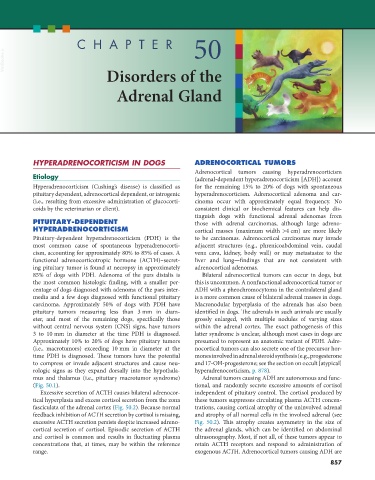Page 885 - Small Animal Internal Medicine, 6th Edition
P. 885
CHAPTER 50
VetBooks.ir
Disorders of the
Adrenal Gland
HYPERADRENOCORTICISM IN DOGS ADRENOCORTICAL TUMORS
Adrenocortical tumors causing hyperadrenocorticism
Etiology (adrenal-dependent hyperadrenocorticism [ADH]) account
Hyperadrenocorticism (Cushing’s disease) is classified as for the remaining 15% to 20% of dogs with spontaneous
pituitary dependent, adrenocortical dependent, or iatrogenic hyperadrenocorticism. Adrenocortical adenoma and car-
(i.e., resulting from excessive administration of glucocorti- cinoma occur with approximately equal frequency. No
coids by the veterinarian or client). consistent clinical or biochemical features can help dis-
tinguish dogs with functional adrenal adenomas from
PITUITARY-DEPENDENT those with adrenal carcinomas, although large adreno-
HYPERADRENOCORTICISM cortical masses (maximum width >4 cm) are more likely
Pituitary-dependent hyperadrenocorticism (PDH) is the to be carcinomas. Adrenocortical carcinomas may invade
most common cause of spontaneous hyperadrenocorti- adjacent structures (e.g., phrenicoabdominal vein, caudal
cism, accounting for approximately 80% to 85% of cases. A vena cava, kidney, body wall) or may metastasize to the
functional adrenocorticotropic hormone (ACTH)–secret- liver and lung—findings that are not consistent with
ing pituitary tumor is found at necropsy in approximately adrenocortical adenomas.
85% of dogs with PDH. Adenoma of the pars distalis is Bilateral adrenocortical tumors can occur in dogs, but
the most common histologic finding, with a smaller per- this is uncommon. A nonfunctional adrenocortical tumor or
centage of dogs diagnosed with adenoma of the pars inter- ADH with a pheochromocytoma in the contralateral gland
media and a few dogs diagnosed with functional pituitary is a more common cause of bilateral adrenal masses in dogs.
carcinoma. Approximately 50% of dogs with PDH have Macronodular hyperplasia of the adrenals has also been
pituitary tumors measuring less than 3 mm in diam- identified in dogs. The adrenals in such animals are usually
eter, and most of the remaining dogs, specifically those grossly enlarged, with multiple nodules of varying sizes
without central nervous system (CNS) signs, have tumors within the adrenal cortex. The exact pathogenesis of this
3 to 10 mm in diameter at the time PDH is diagnosed. latter syndrome is unclear, although most cases in dogs are
Approximately 10% to 20% of dogs have pituitary tumors presumed to represent an anatomic variant of PDH. Adre-
(i.e., macrotumors) exceeding 10 mm in diameter at the nocortical tumors can also secrete one of the precursor hor-
time PDH is diagnosed. These tumors have the potential mones involved in adrenal steroid synthesis (e.g., progesterone
to compress or invade adjacent structures and cause neu- and 17-OH-progesterone; see the section on occult [atypical]
rologic signs as they expand dorsally into the hypothala- hyperadrenocorticism, p. 878).
mus and thalamus (i.e., pituitary macrotumor syndrome) Adrenal tumors causing ADH are autonomous and func-
(Fig. 50.1). tional, and randomly secrete excessive amounts of cortisol
Excessive secretion of ACTH causes bilateral adrenocor- independent of pituitary control. The cortisol produced by
tical hyperplasia and excess cortisol secretion from the zona these tumors suppresses circulating plasma ACTH concen-
fasciculata of the adrenal cortex (Fig. 50.2). Because normal trations, causing cortical atrophy of the uninvolved adrenal
feedback inhibition of ACTH secretion by cortisol is missing, and atrophy of all normal cells in the involved adrenal (see
excessive ACTH secretion persists despite increased adreno- Fig. 50.2). This atrophy creates asymmetry in the size of
cortical secretion of cortisol. Episodic secretion of ACTH the adrenal glands, which can be identified on abdominal
and cortisol is common and results in fluctuating plasma ultrasonography. Most, if not all, of these tumors appear to
concentrations that, at times, may be within the reference retain ACTH receptors and respond to administration of
range. exogenous ACTH. Adrenocortical tumors causing ADH are
857

